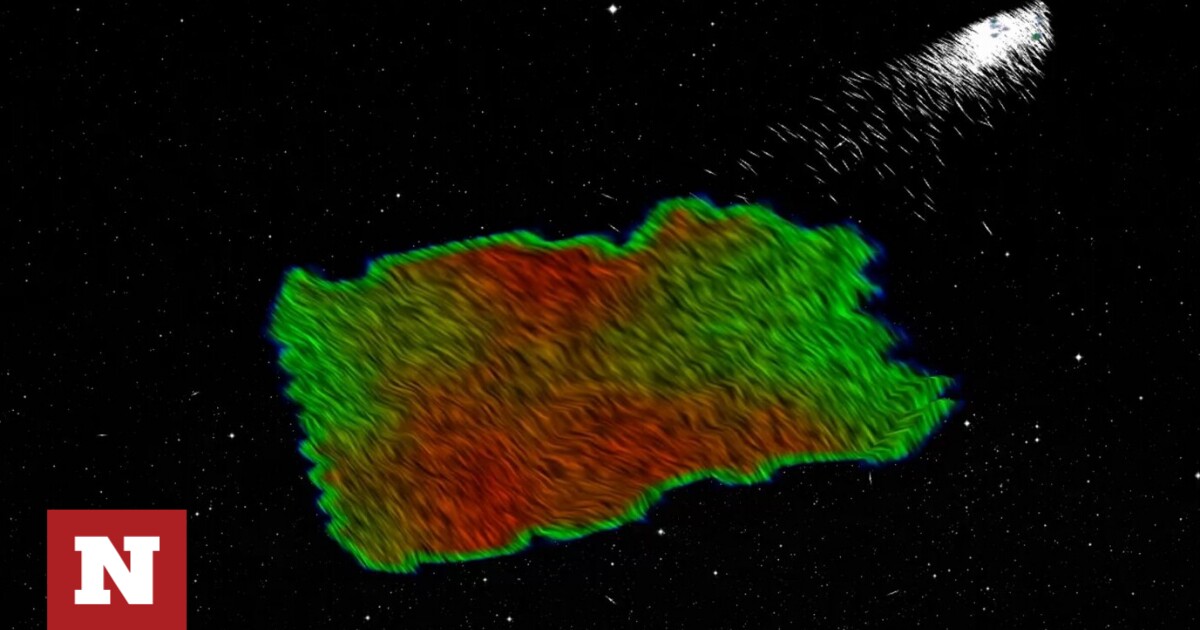
Technology and Research Foundation Announcement
Thanks to new advanced technologies, space missions, and new observational tools,… Astronomy It has entered a new era, where not only the position in the sky can be determined, but also the distance between all celestial bodies from us. Components of our cosmic home, our galaxy – Stars, gas and magnetic fields – It can finally be mapped in three dimensions.
The space between stars is not empty. It is filled with dust whose grains conform to the local magnetic field and emit light. a light Which, moreover, has the property of existence Linearly polarizedthat is, to have a preferred direction in space that overcomes the faint polarization of the cosmic background radiation – The “ashes” of the Big Bang – Which confuses our image in its first moments being. These grains also absorb some of the starlight that passes through them, just as a Polaroid filter does, imprinting information about the magnetic fields in which they live on the polarization of the emerging light. Magnetic fields are very important to the evolution of our galaxyregulating the formation of new stars, the formation of galactic structures and the transformation of gas flows into more powerful cosmic accelerators than CERN.
So the polarization of starlight is key: It contains information about the galaxy's all-important magnetic fields, and is a 'duster' that could help us 'clean up' our picture of the early universe – if only we could observe the polarization of enough stars, and study them carefully, to do so. To extract all the information it transmits.
This is precisely the goal of the PASIPHAE experiment, an international scientific collaboration between the University of Crete, the Institute of Astrophysics of the Technology and Research Foundation of Greece, the Inter-University Center for Astronomy and Astrophysics in India, and the Astronomical Center in South Africa. The Observatory in South Africa, the California Institute of Technology in California, USA, and the University of Oslo in Norway. PASIPHAE's goal is to measure the polarization of millions of stars across almost the entire sky. Now, we can get a first taste of the possibilities of this ambitious project.
a research team, With the first author, Dr. Vincent Pilgrims (until recently a postdoctoral researcher on the PASIPHAE project at the ITE Institute of Astrophysics and now a Marie Curie Fellow at the Joint Higher Energy Institute in Belgium) demonstrated the power of the polarimetric data and algorithms he developed for PASIPHAE, using observations made with the RoboPol polarimeter in Skinaka Observatory on the island of Crete. Scientists measured the polarization of more than 1,500 stars in a region of the sky more than 15 times the size of the full moon, and combined it with the distances measured to each star by the European Space Agency's Gaia satellite and a pioneering algorithm. which has evolved, They mapped the magnetic fields in this direction of the sky.
“This is the first time such a large volume of the galactic magnetic field has been mapped in three dimensions.” He announces enthusiastically doctor. Pilgrims. “We found many dust clouds in this region of the galaxy and were able to determine their distances – up to thousands of light-years – and their polarization properties, revealing the magnetic field that permeates these clouds.”
The team publishes the first cross-sectional map of the galactic magnetic field The sphere is in a fairly large area of \u200b\u200bthe sky, which it presents today Journal of Astronomy and Astrophysics.
“It is a great achievement, and an important step towards mapping our galaxy and its magnetic field.”He says Vasiliki Pavlidou is a professor at the Department of Physics at the University of Crete A collaborating faculty member at ITE's Institute of Astrophysics, he is also a co-author of the publication. “The structure of the galactic magnetic field is currently not known with great precision. This hinders progress in many research areas, such as the study of very high-energy cosmic rays. The possibility of detailed 3D mapping of the galactic magnetic field for the first time will lead to discoveries in all related fields.” This is very important.Ms. Pavlidou adds.
“This work is just the beginning.”S adds Constantinos establishedprofessor of the Department of Physics at the University of Crete and collaborating faculty member at the Institute of Astrophysics of ITE, co-author of the publication and scientific director of the PASIPHAE programme. “Imagine such a map – but for most of the sky!” This 3D atlas of the Milky Way’s magnetic field will become a reality in the coming years, with the help of special WALOPs instruments that will begin mapping the polarization of stars in the sky this year.
Check out the 3D map produced by the team in the video below:
the Pasiphae's experience It is supported by the European Research Council (ERC) of the European Union, the Stavros Niarchos Foundation (SNF), the Infosys Foundation, the National Science Foundation of the United States of America, and the National Research Foundation of South Africa.

“Avid problem solver. Extreme social media junkie. Beer buff. Coffee guru. Internet geek. Travel ninja.”





More Stories
In Greece Porsche 911 50th Anniversary – How much does it cost?
PS Plus: With a free Harry Potter game, the new season begins on the service
Sony set to unveil PS5 Pro before holiday season – Playstation